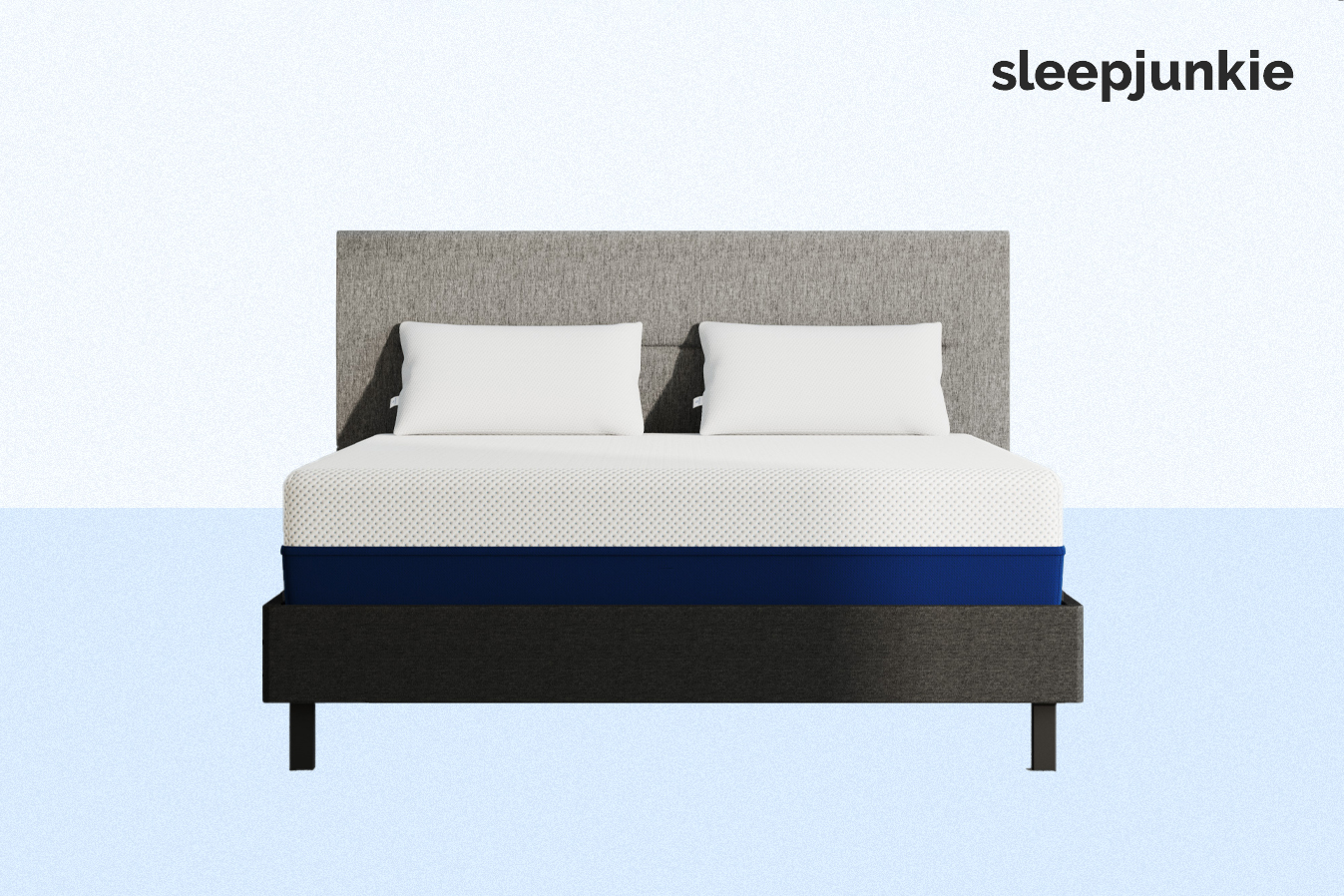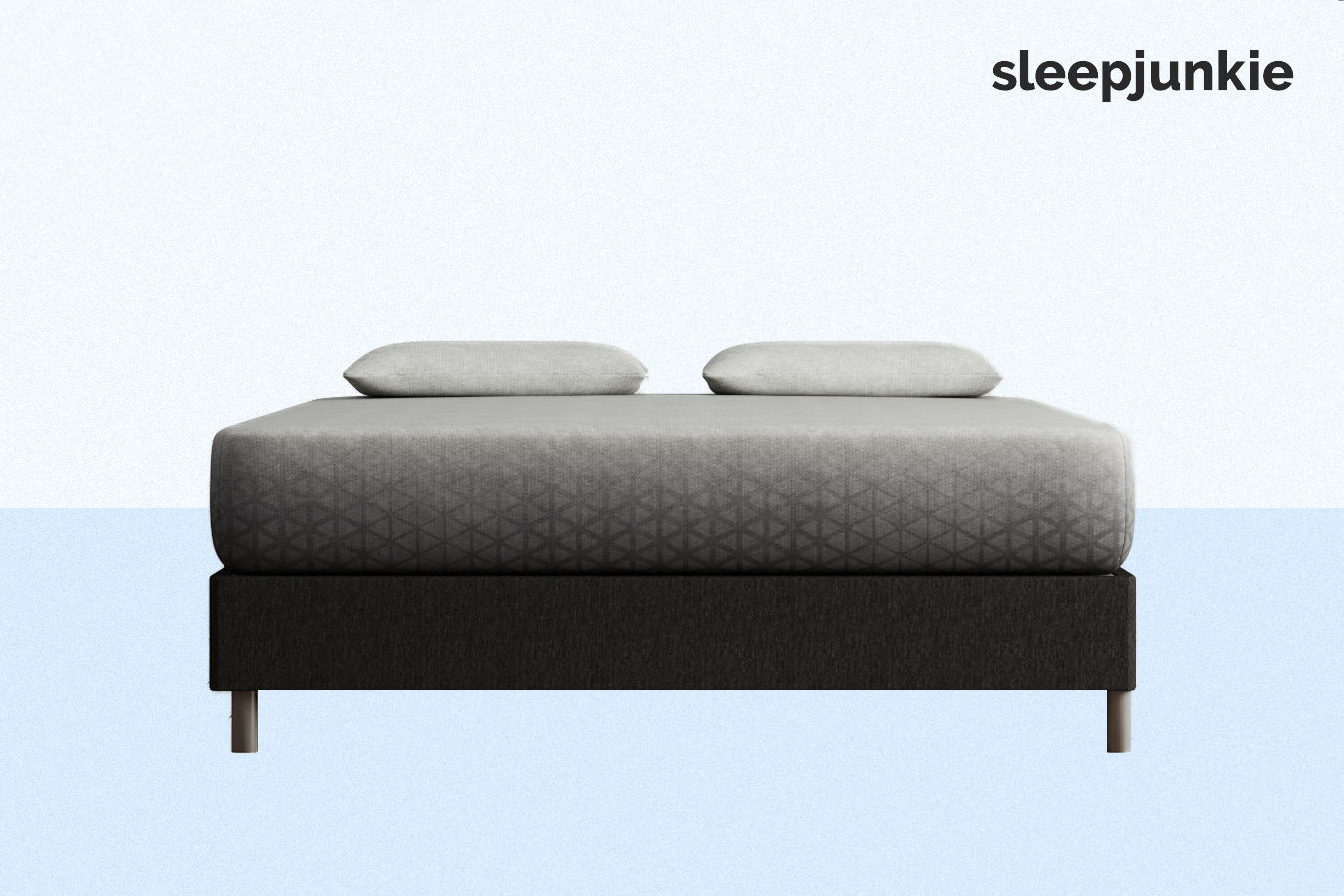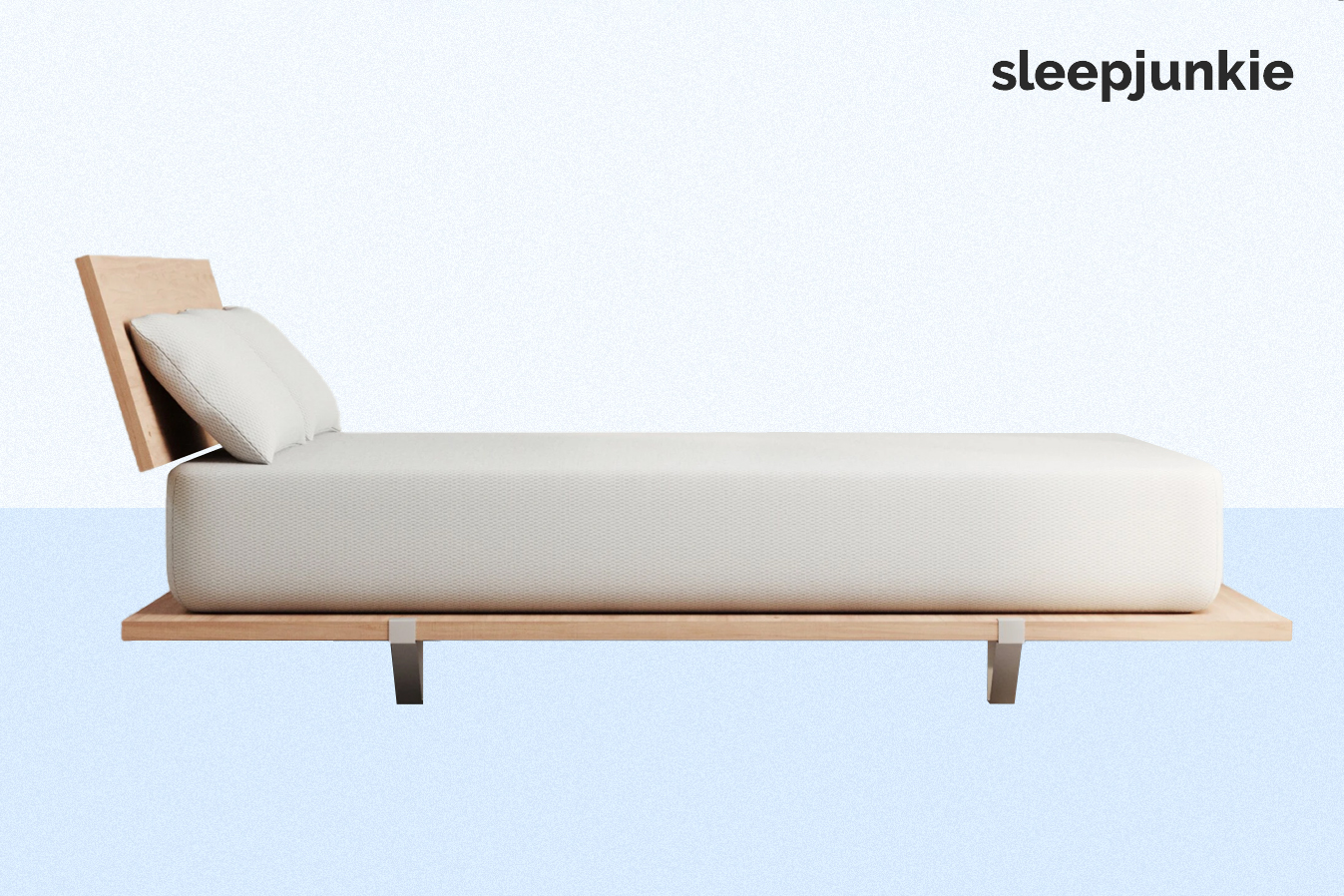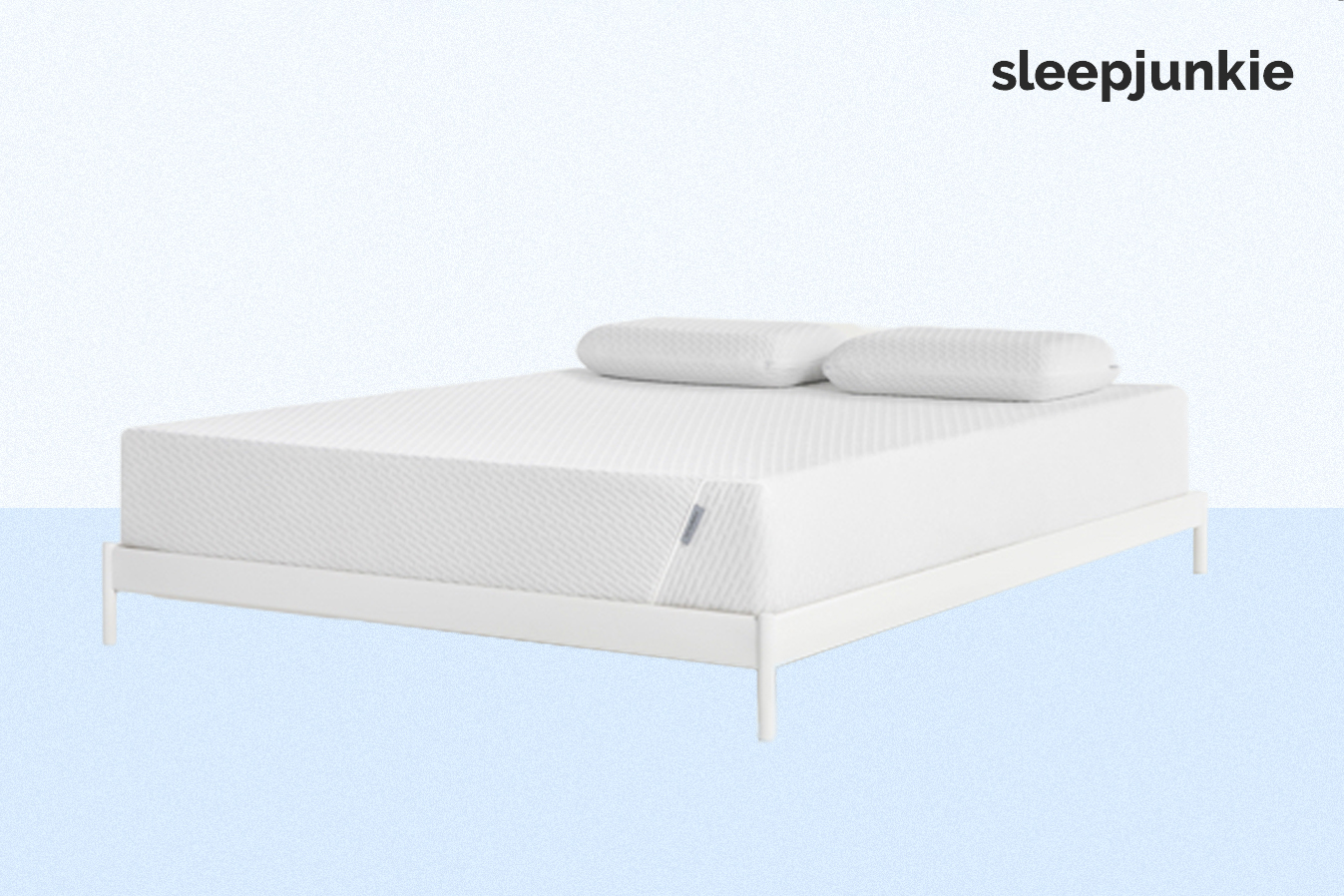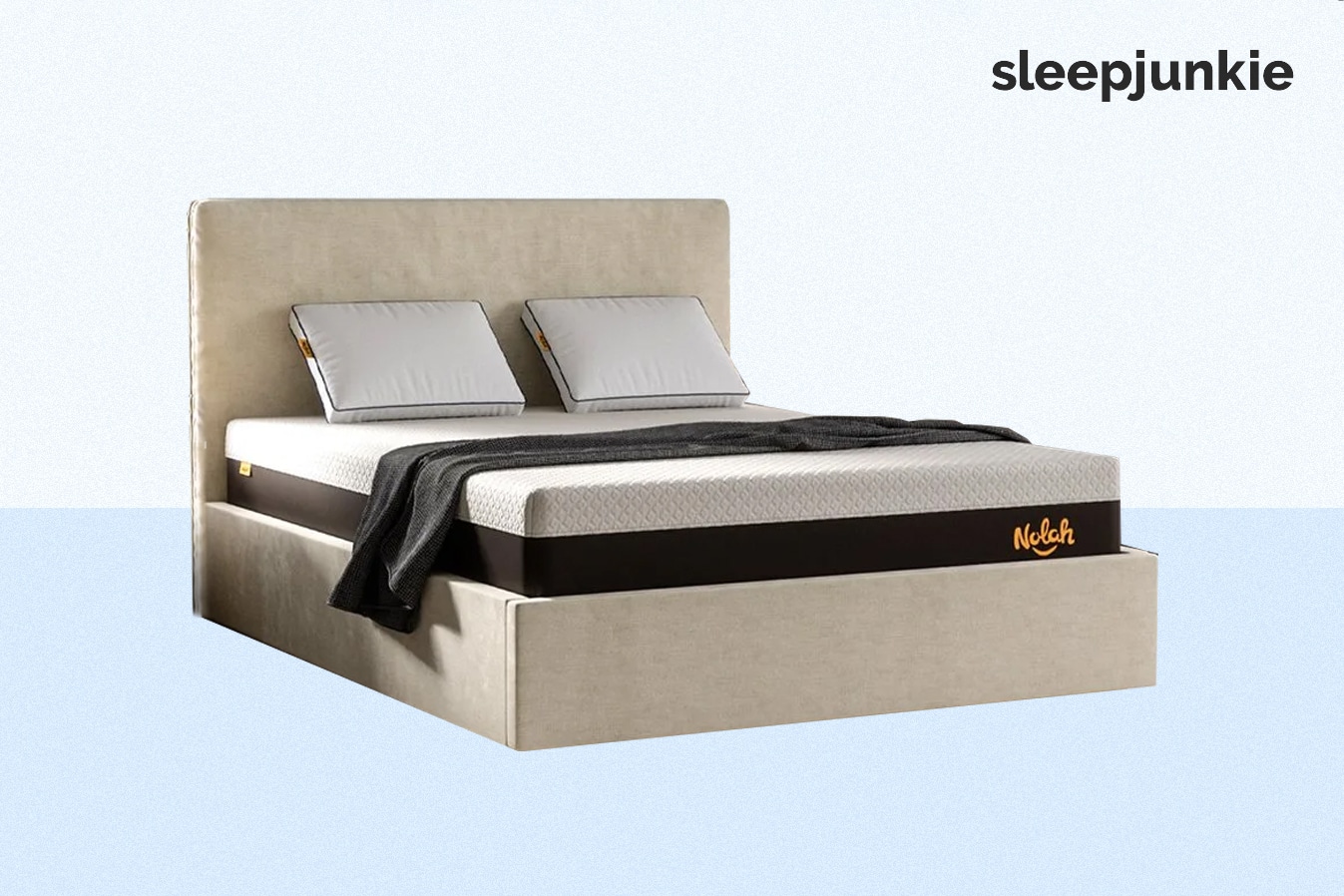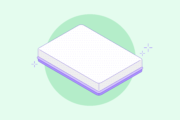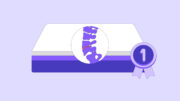Best Mattress for Sciatica: Reviews and Buyer’s Guide
Dr. Jennifer Miller, PT, DPT: Expert Physical Therapist and Pelvic Health Specialist
Dr. Jennifer Miller is a compassionate and skilled outpatient physical therapist with nine years of experience in the field. She earned her Doctor of Physical Therapy from Elon University and holds a Bachelor of Science in Health Science from Minnesota State University-Mankato. Dr. Miller specializes in Neurological, Geriatric, and Vestibular Physical Therapy and serves as […]

According to Harvard Health Publication, up to 40 percent of people will be affected by sciatica in their lives.
Sciatic pain originates from the inflammation and pressure placed on the sciatic nerve, or nerves originating from the spinal cord when they are pinched or irritated.
Thankfully, 90 percent of people recover from nerve irritation without surgery. In this post, we discuss how the right mattress and sleep habits can alleviate your pain.
30 Second Summary: Best Mattress for Sciatica
- Amerisleep AS3 — The Editors’ at Sleep Junkie recommend Amerisleep’s AS3 as the best mattress for sciatica. The AS3’s featured pressure-relieving Bio-Pur® foam and zoned support technology deliver restorative sleep.
- Zoma Mattress – We like the Zoma Mattress for sciatica relief because it contains Triangulex™ technology and pressure-relieving memory foams to help you get more comfortable sleep.
Best Mattress for Sciatica
As our top recommended mattress, the Amerisleep AS3 has all the qualifications as the best mattress for sciatica, including support, conformability, firmness, and motion isolation.
Beneath a soft, breathable cover is a layer of pressure-relieving plant-based memory foam layer called Bio-Pur®. This foam is designed to wick away moisture and contour to the body to provide pain relief. This layer helps the spine lie in a neutral position, discouraging future back pain.
Below the Bio-Pur®, HIVE® technology fosters solid support to the hips and lumbar region and comfort to the head, shoulders, and ankles (the 5 different support zones). The hexagon cut-outs create passages through the mattress, aiding in cooling by allowing air to pass through the mattress.
The final layer, Bio-Core® acts as a foundation for the entire mattress. This layer gives the mattress its longevity and ensures the sleeper has a solid, even sleeping surface.
All Amerisleep mattresses are backed by a 20-year warranty and a 100-night sleep trial.
AMERISLEEP AS3
- Features pressure-relieving, plant-based memory foam
- Provides zoned comfort and support
- Comfortable for all sleeping positions
The Zoma Mattress is another great bed for sciatica relief due to its inclusion of Triangulex™ technology. The Zoma was originally designed to help athletes sleep deeper and recover faster, so it’s well-equipped to relieve pain and prevent future discomfort.
The Zoma Mattress has three layers and stands 11 inches tall. It’s designed to feel medium in firmness, so it should offer a good balance of comfort and support.
The first layer of Zoma is 2 inches of gel-infused memory foam. When you lay on the Zoma mattress, this comfort layer molds to your body to offer some cushion and alleviate pressure. The gel within combats body heat to keep you sleeping at a comfortable temperature. In this first layer is where Triangulex™ technology is included.
Triangulex™ is a zoned support technology that firmer under your torso and softer under your shoulders and hips to facilitate proper spinal alignment and prevent uncomfortable sinkage.
The second layer of Zoma is Reactiv™, a latex-like poly-foam. Because Reactiv™ is responsive, it gives the bed a bit of bounce and reinforces the Triangulex™ technology above. Together, Reactiv™ and Triangulex™ hold your spine in neutral alignment and alleviate pains at the source.
The third and final layer of Zoma is 7 inches of Support+, a durable poly-foam. Support+ gives the bed shape and structural integrity. Plus, Zoma backs each of their mattresses with a 10-year warranty to protect against sagging.
The Zoma Mattress can be bought online-only and comes with a 100-night sleep trial.
ZOMA MATTRESS
- Gel memory foam combats body heat and keeps you cool
- Comfortable for side and back sleepers
- Triangulex™ technology promotes proper spinal alignment
Many people lack the money to buy a pain-relieving mattress with all the bells and whistles. However, a mattress with a simple design can still relieve aches and pressure. Budget shoppers and bargain hunters seeking an inexpensive way to alleviate sciatic pain should consider the Vaya Mattress.
The Vaya Mattress stands 12 inches tall and contains two foam layers. The bed has a responsive feel designed to support all sleeping styles.
The top layer is 3 inches of Vaya Comfort Foam, a material that can contour to the body in any position. If you change position, the foam is quick to adapt with its responsive support. Plus, the comfort foam’s lightweight design helps heat escape, ensuring a cool sleep surface throughout the night.
The bottom layer is 9 inches of Vaya Base Foam, a sturdy material that promotes a long-lasting mattress. This supportive material ensures the spine stays in a neutral position while a person rests.
You’ll find the Vaya Mattress online. Every purchase includes a free Vaya Pillow, a 100-night sleep trial, and a 10-year limited warranty.
VAYA MATTRESS
- Conforming Vaya Comfort Foam eases pressure and pain
- Supportive base foam evenly distributes body weight
- Two-layer design promotes a surface suitable for all sleepers
If you’re unsure whether a soft or firm mattress is the better way to alleviate your sciatica, you might want to try the two-in-one Layla Hybrid. Most modern mattresses aren’t flippable, but the Layla Hybrid is one of the few exceptions. Each side has a different firmness, establishing a mattress that suits most sleepers.
The Layla Hybrid is a mix of foam and bouncy coils and is compromised of five layers.
The comfort layer of the soft side is 2.5 inches of copper gel-infused memory foam. The cooling copper infusion also keeps bacteria from taking up residence in the mattress, while the memory foam eases pressure across the body.
The transition layer is 2 inches of Max Airflow Support Foam. The channels along the foam provide targeted support and air circulation.
The middle layer is 6 inches of Infinity Edge™ pocketed coils, reducing motion transfer. The coils along the side also provide edge support, making it easier to move out of bed.
Two layers make up the bed’s reverse firm side—1.5 inches of Max Airflow Support Foam and an inch of copper-gel memory foam. Completing the mattress is a soft, breathable fabric cover that can be removed by unzipping it. The bed’s sides also have handles for easier flipping.
Your Layla Hybrid includes a 120-night trial and a 10-year warranty. Not only does a Layla Hybrid come with a sleep trial and warranty, but also two free pillows.
LAYLA HYBRID
- Heat-wicking and antimicrobial copper infusion
- Pressure-relieving memory foam
- Responsive coils with edge support
Like the Layla Hybrid, the Nolah Signature possesses a flippable design with soft and firm sides. Unlike the Layla Hybrid, which uses memory foam in its comfort layers, Nolah relies on a unique material, Nolah AirFoam™, that’s designed to offer more pressure relief than traditional memory foam.
The Nolah Signature possesses four layers to create a soft and firm side. Let us examine the bed from the soft side down.
The first layer that establishes the mattress’s soft feel is 2.5 inches of Nolah AirFoam™, a breathable and durable foam that conforms well to the back and hips.
Underneath the AirFoam™ is 1.5 inches of high-resilence foam, engineered to be more sturdy than latex. This transition layer increases the mattress’s inherent bounce, ensuring the soft side doesn’t swallow a sleeper’s body.
The mattress’s core is 7 inches of high-density base foam with an airy construction. The reverse side of Nolah AirFoam™ is an inch thick for a firmer feel.
The fabric cover that surrounds the mattress’s layer is organic cotton, produced without dangerous or harsh chemicals. The cotton wicks away moisture and heat to maintain a cool, dry surface.
The Nolah Signature comes with free shipping, a 120-night warranty and a lifetime warranty.
NOLAH SIGNATURE 12
- Removable trial period to save money
- Lifetime warranty to protect the mattress
- Two-sided mattress with contrasting firmnesses
What is Sciatica?
The condition, sciatica, directly correlates to the welfare of the Sciatic Nerve. If the nerve is agitated it may cause the individual sharp pain beginning in the sciatic nerve down to the hips, posterior, and legs. These pains are what characterize sciatica.
Typically, the pain is more intense on one side. However, both sides could be affected.
Someone affected by sciatica often experiences numbness and weakness on the affected side(s). If you experience loss of bladder and bowel functions, you need to contact your doctor immediately, as this could be a sign of a more serious condition.
Causes
- Herniated Disks (Slipped or Ruptured Disks): When the outer layer of the gelatinous disk is punctured or torn, the cushioning liquid will spill out and create a bulge that might press against the sciatic nerve.
- Bones Spurs (Exostosis): An irregular bone formation grows on top of the already existing bone.
- Spinal Stenosis: The narrowing of the spinal canal, which in turn places pressure on the sciatic nerve.
Risks
- Age: As our bodies grow older, they do not function as well as they did when we were young. Natural changes such as deterioration of the spine can lead to sciatica. Typically, the result of spinal deterioration originates from years of sleeping wrong, lifting more than the body was capable of, or a lifetime of sitting at a desk job or hard laborious work.
- Obesity: Excess weight places pressure on the spine. Since the spine is under continuous pressure, people who are overweight will eventually experience pinching and irritation from the sciatic nerve.
- Diabetes: Naturally, diabetes causes nerve damage. Especially if the condition isn’t treated properly. The disease usually starts at the feet or fingers and makes its way up to the rest of the body. Unfortunately, the sciatic nerve might eventually be included among the nerves affected.
- Occupation: Those who work physical labor or a desk job with long sitting periods have an increased chance of suffering from sciatica. Hard labor jobs include a lot of lifting, twisting, pulling, and straining, which places strain on the spine. Meanwhile, desk jobs can place strain on the spine with the long sitting hours.
Treatments
- Medication: Depending on the patient’s medical history and lineage, the physician may prescribe anti-inflammatories, muscle relaxants, narcotics, antidepressants, or anti-seizure medications.
- Physical Therapy: Along with medication, body rehabilitation is a more common treatment. Increasing flexibility and muscle strength have proven to be very beneficial to those with this type of chronic pain. Improving posture is another method of physical therapy that will be addressed. Dr. Jennifer Miller, Physical Therapist, recommends the following on how to prepare for your physical therapy appointment: “Pay attention to what makes your pain better or worse, are there certain positions or tasks that increase your pain? Bring a list of current medications and treatments you have tried with your doctor. Make sure to arrive early to fill out questionnaires, so the physical therapist (PT) can provide you with the best individualized care possible. You can expect the physical therapist to ask you about your medical history and how the pain has been impacting your life. The PT will then take you through different tests and measures to ensure the best treatment plan for you. You might receive a few exercises during the first visit and then more at subsequent treatment sessions. The exercises might include stretches and strengthening to decrease your pain.”
- Steroid injections: Steroids are prescribed only for severe cases. Injected straight into the sciatic nerve, though rare, this treatment could have severe consequences: paralyzation, high levels of pain. Due to the risk of this treatment and efficacy of each injection, it will be used several times over the course of a few months.
- Surgery: Once again, surgery will only be offered to those suffering from severe cases of sciatica.
What to Look for in a Mattress
For someone with chronic back pain, finding the best mattress can be essential to living and sleeping well. The question is which type of mattress will help relieve pain and help you sleep better?
Mattress sellers have found that people who have sciatica tend to lean towards memory foam and latex mattresses. The close contouring and solid support of both mattresses make up a major reason why these mattresses are preferred.
While everyone needs a good supportive mattress, those suffering from sciatica need this support to alleviate the pressure from their spine.
It can be tempting to purchase a soft bed. Soft things have the stigma of comfort and pain-relief; however, this isn’t always the case for mattresses.
Soft beds are fantastic pressure relievers for side sleepers. But those that have sciatica need something a little more firm, even if you are a side sleeper. For other sleeping positions, too soft a mattress will cause too much straining, making a firm mattress the best option.
On top of a supportive mattress, close conforming materials are needed for pain relief, which makes latex and memory foam mattresses ideal.
While support conditions your spine into a neutral resting position, contouring will conform to your spine to provide above-average pain and pressure relief.
Latex and memory foam mattresses have fantastic motion isolation. Chronic pain can be aggravated by motion. So, by purchasing a mattress that stops motion at the point of impact, pain is effectively reduced. It also stops a person from waking due to the movements of a sleep partner.
Mattress Types
We highly suggest sticking with the recommended memory foam and latex mattresses; however, that doesn’t mean that you are limited to those mattress types. There are many different types of mattresses made with different materials.
Read on to learn more:
- Innerspring Mattresses: In America, the innerspring mattress continues to be the most popular. Nicknamed the “traditional mattress,” innerspring mattresses first appeared in the 1800s. Its defining characteristic is the support it gives the sleeper, which is attributed to the coil core the mattress utilizes.
If you are someone with sciatica looking to buy this type, watch for a mattress with a zoned support system.
- Latex Mattresses: First developed in the 1920s, the latex mattress has progressed by leaps and bounds as the most supportive mattress available on the market.
It’s made from the sap of the rubber tree. There are two different ways the latex can be produced: Talalay and Dunlop. Depending on the method of production, the latex will have some differences.
The Dunlop method will produce a mattress with a firmer sleeping surface, which isn’t the best if you’re looking for conformability; meanwhile, the Talalay method produces a material with equal support and better contouring.
For those with sciatica, we suggest getting a mattress with material produced by the Talalay method.
- Memory Foam Mattresses: Memory foam matches latex both in support and contouring. As one of the newer mattress materials to hit the market, memory foam quickly became popular for the pain relief it offers its sleepers.
Although the first initial foam mattress had heat retention issues, modern memory foam mattresses have eliminated these issues through the combination of open-cell construction and cool-promoting material infusions.
- Hybrid Mattresses: By taking the best of innerspring, latex, and memory foam mattresses, the hybrid mattress was placed on the market with riveting success. Because they’re made in so many different ways, these mattresses can be directed to any type of sleeper and highly recommended to those on the heavy side.
Sleeping Positions
Learning how to sleep well in your preferred sleeping position can have as many benefits as a new mattress. For many sciatica patients, their pain increases when they lie down. Some have even gone through the lengths of sleeping while sitting or lying on the floor to have a brief moment of pain alleviation.
- Back Sleeper: This position allows the spine to rest in a neutral position without the use of many pillows. Those with sciatica will want to place a wedge pillow under their knees to alleviate tension in their hips and lower back.
- Side Sleepers: Sleeping on your pain-free side is one of the better positions when you have sciatica since it avoids putting direct pressure on your back. In this position, a sleeper will need to use several pillows, like a knee pillow, to ensure the neutrality of their spine.
We highly suggest a body pillow, as it will cancel the need for multiple pillows and offers more support.
Securing a pillow under the head and between the legs will stop the misalignment of the spine. To stop yourself from turning over you can place a pillow at your front or back. If you decide to employ the use of a body pillow, the front and back support will already be provided for you.
- Stomach Sleepers: Sciatica can be caused by sleeping on your front. The pressure that builds on the spine derives directly from the unnatural flattening and the pressure that builds up as a result of the sleeping position.
In the case that you are a stomach sleeper, we highly suggest you switch to side or back sleeping. If this isn’t an option, place a pillow or a rolled towel under your hips to preserve the natural curve in the spine. Sleeping without the use of a pillow in this sleeping position furthers the preservation of that curve.
Frequently Asked Questions
What mattress type is best for sciatica?
Memory foam and latex mattresses are good choices for people with sciatica, whether they’re all-foam or hybrid models. We suggest people with sciatica stay away from traditional innerspring mattresses, which lack the conforming features of a foam mattress. Often, innerspring mattresses let pressure build up, worsening any pre-existing pain.
Can a bad mattress cause sciatica?
There’s little chance of the wrong mattress causing your sciatica, but sleeping on a bad bed can certainly make it worse. If your mattress is old and unsupportive, you’ll want to replace it with a new one that can maintain a neutral spine position. Just make sure you choose a firmness that matches your sleeping style.
What mattress firmness is best for sciatica?
A too-firm or too-soft mattress can worsen sciatica by letting pressure points build up across the body. However, there’s no one true firmness perfect for sciatica because people have different sleep styles, determined by their sleep position. We recommend back or side sleeping for people with sciatica, which each require a different firmness range:
- Back sleepers should look for medium to medium-firm mattresses.
- Side sleepers prefer soft to medium mattresses.
What mattress is best for back sleeping with sciatica?
A mattress for back sleeping should balance uncompromising, responsive support with pressure-relieving conformability. Back sleepers usually find a medium-firm feel offers what they need. However, a medium mattress with targeted lumbar support can provide a welcome touch of cushion.
What mattress is best for side sleeping with sciatica?
The best mattresses for side sleeping feature a soft, conforming surface to ease pressure points. Yet the mattress should also feature a strong support core to buoy the spine and keep it in its neutral position. Side sleepers with sciatica might want to try a medium to medium-soft mattress, though a petite side sleeper might benefit from a fully soft mattress.
Research and Resources
In making this article, we…
- Researched dozens of mattress brands, reading about the materials they use, their manufacturing process, and what goes into making a high-quality, long-lasting mattress.
- Weighed the pros and cons of each kind of mattress you can buy, and who each kind of bed is best suited for.
- Spent 15 hours writing and revising the article to deliver the most value-driven, helpful content to our readers looking to find the best bed for their sleep needs.
Did You Find Your Next Bed?
Chronic back pain can be nerve-wracking. Whether you’re looking for a firm or even an extra-firm mattress to support your back or a contouring mattress, memory foam and latex mattresses are our suggestions when choosing a bed for sciatica.
If you want our best firm mattress options, head on over to our post.
